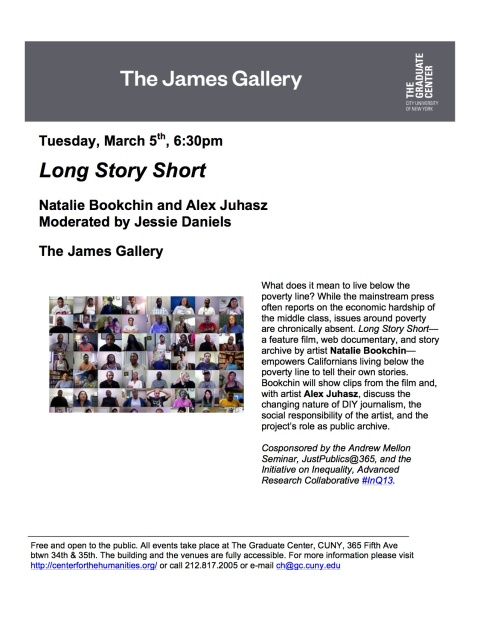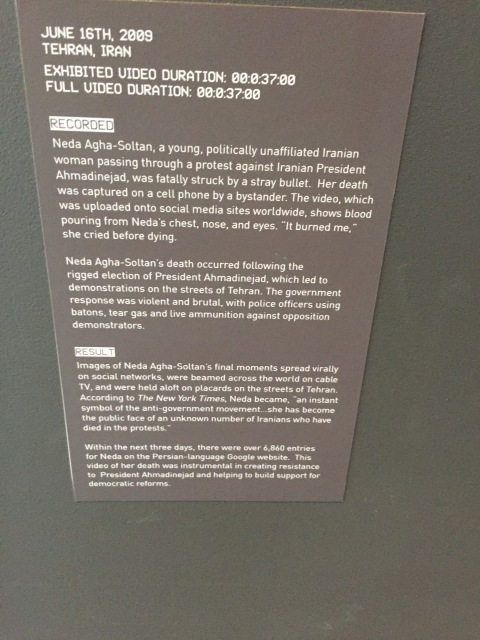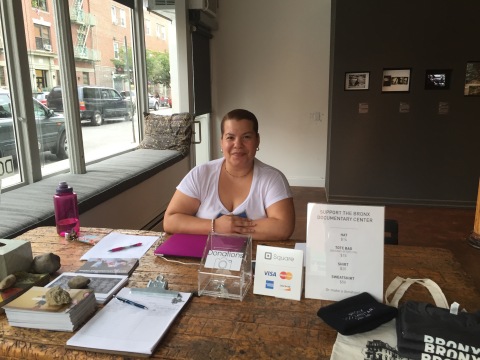#32, take responsibility for our own acts of looking
March 5, 2017
Last summer, in “How Do I (Not) Look, Live Feed Video and Viral Black Death,” I wrote:
We come to this cultural, political and media onslaught as individuals but, it is my contention that each of us must take responsibility for our own acts of looking. When we look (or write) we engage in the regimes of visibility—complex networks of power, ownership, and access that frame our viewing and knowing—that surround and inform violence. Accounting for our place, our needs, our actions in the face of viral videos of murder is one within a constellation of necessary ethical and political acts … when we have the choice to look, we are bound ethically and politically to what we witness and what we do with all we have seen.
What would be an ethical look at Fatima Avelica‘s cell phone video record of her father’s tragic arrest by ICE? Given the ubiquity of such images, their sheer unavoidability, is there more to be done then seeing, feeling, and then sharing? I choose two possibilities from my earlier response as a place to start and conclude with a third written today:
1) look askance: “also look carefully elsewhere—away from documents of the act of violence itself—to do the harder work of seeing the ‘causality, responsibility, and impact’ that often (or must) go unseen, even as (or so that) violence is made increasingly visible.”
2) look at death’s platforms: “Ethical viewing considers not just our own looking at viral videos but at the broader political-economic and technological structures that produce, hold, and frame the videos that we see and share.”
3) look, feel and then do: Avelica’s video uses sound to effectively produce melodrama. Her anguished sobs render an emotional truth and impact on what would otherwise be a too-common, easily-expendable largely-unshared image of the definitive, daily, and increasing violence enacted against primarily brown and black people by the police, ICE, and other agents of our state. But the honest emotional charge written into the DIY composition of Avelica’s video has guaranteed its momentary virality, its massive seeability, and seen it will be: albeit quickly, interchangably, and surrounded by other things. How could its fleeting (over)visibility be used to motivate more?
Before we look, I would ask you to consider: what would honoring my three ethical looks look like? I might suggest that my previous 31 #100hardtruths, rendered here on the internet as a complex and building series of montages of images, analyses and links to resources—posts that take me real time and effort to write and share—represent one manifestation of this harder work.
Or, I could build a ramp to the viral video, that moves from causality:
to impact: Paying the Price: The Impact of Immigration Raids on American Children (The National Council of La Raza, 2007).
Alternatively, attending to my second suggestions for possible ethical looks, I could build a ramp to the viral video that moves from the broader political-economic and technological structures that produce

“Today, millions of consumers love and live by their iPhones, but what are the implications of its special technology on society, media, and culture?”
and frame the videos we see and share.
Or I could ramp to the video with possible actions
or agents that can help
to address and build upon the powerful but usually fleeting emotional appeal of what we see and share.

My Brooklyn College colleague, Lindley Hanlon, after attending another anti-Trump immigration policy demo.
I hope it’s clear what I’ve tried to rather awkwardly demonstrate, limited as I am by the vertical design features of this (and any) blog. Giving time to build structures that hold viral images, and taking time to frame our viewing of them, are possible ethical projects of looking in a time where the speed and volume of image production and consumption equates rather tragically to the speed of image forgetting and a linked sense that there might be nothing to do in the face of the very real violent tragedies that such images record.
I am convinced that we can do more:
- National Network for Immigrant and Refugee Rights
- Mixteca
- Moving Data: The iPhone and the Future of the Media, Pelle Snickars and Patrick Vonderau, eds.
- #100hardtruths-#fakenews: a primer on digital media literacy
Stacked on Her Office Shelf: Stewardship and AIDS Archives
January 16, 2017
This is my third conversation with Ted Kerr. We begin to consider what might be needed so that many inheritances of AIDS could be salvaged, shepherded, and mothered into a legacy of plenty. Read it CUNY’s Center for Humanities newsletter.
Web Resources and Activities for Peace, 1: PALESTINEDOCS
August 23, 2014
Last Thursday, I received a group email from two European professors of cinema—Dina Iordanova, Professor of Global Cinema and Creative Cultures, University of St. Andrews, Scotland, and Eva Jørholt, Associate Professor of Film Studies, University of Copenhagen, Denmark—alerting me to the inauguration of their website PALESTINEDOCS: “a web resource on films chronicling the life of Palestinians in and outside the Middle East.”
After looking at their welcome page and the amazing set of documentaries and linked resources made available (as well as who was cc’ed on the email and the authors’ bios, as I did not know either of them personally), I began to think about their digital activity in light of my two recent posts on activism, media, and digital engagements in support of peace. While it was never my intention to say activism is not possible on the Internet, or Facebook more specifically, I was trying to better understand my own discomfort with the changing norms, practices and volume of digital actions, displayed by myself and my “friends,” who seem to be engaging in our “political” action (or action about politics) about the current Israeli/Palestinian conflict, primarily inside the hidden (and sometimes visible) boxes of corporate-owned digital spaces.
I think that Iordanova and Jørholt’s activity helps us to see where engagement on the Internet can be more productive than what I continue to see as proto-political activities we are mostly engaging in around this and other conflicts this volatile Summer: refining and sharing our own positions within complex Internet communities. (Tellingly, that’s how these two producers found me; I was a signatory on a public protest letter which they saw online and which led them to believe I would be interested in their project, as I proved to be).
PALESTINEDOCS mobilizes the Internet’s not unique but heightened affordances of accessibility, transnationality, and instantaneousness (see their welcome remarks) in ways that seem very well suited for movements for peace. “We hope that it would be an advantage to make use of the ‘click through’ access that we provide to most films, as many are available for viewing directly on the Internet,” explained Iordanova to me in a later email. The project activates and is based in a winning set of media actions that begin with the building of this digital resource, and continue with further actions requested in their email (telling others about it, as I am doing here, online; and writing film commentary for the site to help others to better watch, understand, and teach these complicated and diverse films and the controversial and moving histories they document), all this potentially promoting even more actions (viewing documentaries on a laptop, screenings in groups, teaching, reading more, discussion online and off).
PALESTINEDOCS is a project by (and for) scholars (and students) of cinema, and documentary more specifically. “We wanted to DO something, and as film scholars – not doctors, diplomats or even filmmakers – we thought of the site as a means to make more people aware of what it means to be Palestinian,” explained Jørholt in a later email to me. Many documentary scholars, makers, and viewers (like myself) are interested in understanding (and mobilizing) documentary media’s function as activism (and often questioning whether it is activism…) Jorholt explains what moved her to make this site in light of such questions:
Media and social justice … that’s a vast and complex issue. A brief answer would be that films have the capacity to focus on human beings rather than abstract political disagreements and clear-cut warring camps. They may thus be able to sensitize public opinion – and help bring about social justice – in a much more powerful and nuanced way than news reports on mainstream mass media. Provided that the films are seen, of course …. which is where the site can make a difference. Hopefully …
But I will end, where I often do, exhorting us to link our work in representation to (further) actions in the world (including the Internet and the world of media, to be sure). Yes, watch one of the films alone on your computer, but better yet, watch it in a group and talk about it after; share information about this site and other useful resources; write some analysis and share it with someone who may not agree; make your own documentary; go to a protest or teach-in and share your documentary or one of those here; build your own site holding the documentaries you think might add to a conversation supporting peace (for instance, I’d love to see a similar venture about Jewish voices in the diaspora committed to representing peace, for that’s something near and dear to my heart that I’ve seen too little of!)
Long Story Short, NYC
February 22, 2013
 Natalie’s film is an inspiring mix of digital storytelling and artistic vision. Hope to see New Yorkers there!
Natalie’s film is an inspiring mix of digital storytelling and artistic vision. Hope to see New Yorkers there!
When ACT UP is remembered … On Visual AIDS
February 17, 2013
Visual AIDS: What will be the benefits of Queer Archive Activism? (Specifically I am hoping you can comment on the benefits for those who made video and film art in early response to HIV/AIDS, and those who are recontexualizing it now. And of course, generally what are the benefits.)
The benefits to our nostalgic return are threefold:
1) it fosters our own public and interactive remembering, “healing” (although this is not something I am seeking, personally: I don’t really want to heal, I’d rather stay angry or at least contemplative), and interaction.
Read the rest of the second part of this two-part interview on Visual AIDS.
“How can we understand this moment of ‘AIDS Crisis Revisitation’, exemplified by the success of films like United in Anger and How to Survive a Plague. Video artist, activist, and academic Alexandra Juhasz provides some insight.
Making and thinking about AIDS activist video since the mid 80’s, Juhasz coined the term “Queer Archive Activism”. In this first of two blog post Visual AIDS interviews her about her term and in the next post we flesh how Queer Archive Activism works in the world. Visit Alexandra Juhasz’s website.
Visual AIDS: Can you tell me about your phrase Queer Archive Activism? What does it mean? Where did it come from?
see my answers on Visual AIDS’ website!
Palm Springs Art Museum Programs Coincide with World AIDS Day
November 28, 2012
Please do pass the word, as reported on Palms Springs Life:
“Although the day is titled, A Day With(out) Art, the opposite will be true Saturday (Dec. 1) at the Palm Springs Art Museum.
The museum will present a series of art forms to coincide with the World Health Organization’s World AIDS Day, which began in 1989. Admission is free.
Robert Atkins, co-founder of Visual AIDS, which created A Day With(out) Art 24 years ago as a day to use art to raise awareness and honors those who have died of AIDS, will lecture on In Mourning and In Rage as part of the day’s theme: – In Memoriam: Loss, Identity and History in the Age of AIDS.
There will also be a screening of the film, Video Remains, a documentary by filmmaker Alexandra Juhasz to honor her best friend in his final days, and a panel discussion about memory and loss.”
The schedule of events is here.

Alex and Michael, at Rudy’s Barbershop, Silverlake, still from Video Remains.
Grrr-Ls
April 20, 2012
That’s grrr, like annoying, not Riot. Cuz there’s none of that in Girls (not to mention women of color).
In the early 1990s, I was around 25 and I already thought of myself as a woman when the grrrls played New York (I remember seeing them at ABC No Rio when my friend Alex Sichel was planning to make a movie about the scene [All Over Me, Sichel, 1997]).
But those nineties girls—a little younger, perhaps somewhat all-around less privileged, and still pretty white—fell back upon their generation’s love of Grunge, connected to a previous generation’s feminist rage, and espoused their own avowedly political commitment to the politics of expression. Meanwhile, Dunham’s new girls—yes, just one visualization of “her generation”—are separated, sequestered, cocooned off from the any sense of history, community, or body of (feminist) work or (political) thinking or (artistic) practice beyond their narcissistic dreams of socially-mediated “artistic” cross-over (or selling-out as we called it) and passing sexual pleasures (perhaps one of them will be lucky enough to become someone like Lena Dunham, although cuter). I do like some of it to be sure: their world-of-women and -self sometimes separated from men or hetero-coupledom; the unromantic depiction of young-hetero-sex and girls’ desire; Dunham’s funny, quick patter. However, I mourn the loss of Tiny Furniture’s uniquely 2000’s DIY sensibility (not so much grunge as google), where a YouTube-inflected sensibility, even if a tad studied, prevailed: “bad” camera-work and acting, no make-up, and a plot-line about Lena’s own YouTube celebrity. The HBO girls have been prettied up, as has Dunham’s craft, thanks to the goodies of her rise out of social media.
But it’s Dunham’s inability to connect (and not in that Facebook makes us lonely way) that leaves me the most enervated. I spoke about this generational phenomenon (my qualms about the return to the personal in works by the “younger generation”) in my responses to Pariah which I think allows us to re-think the real race-problem in Dunham’s work as also a generational-political one.



















